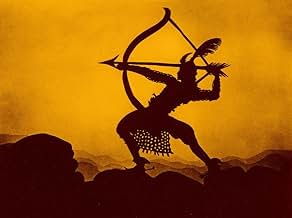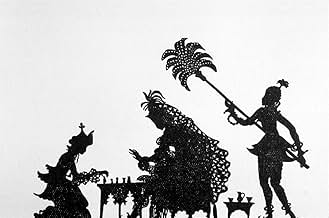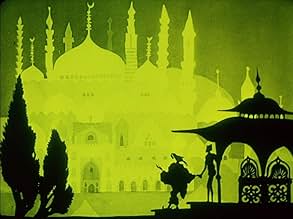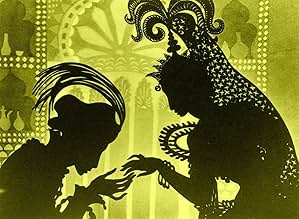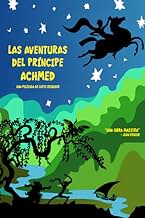CALIFICACIÓN DE IMDb
7.8/10
7.4 k
TU CALIFICACIÓN
Un apuesto príncipe monta un caballo volador por tierras lejanas y se embarca en aventuras mágicas, como hacerse amigo de una bruja, conocer a Aladdin, luchar contra demonios y enamorarse de... Leer todoUn apuesto príncipe monta un caballo volador por tierras lejanas y se embarca en aventuras mágicas, como hacerse amigo de una bruja, conocer a Aladdin, luchar contra demonios y enamorarse de una princesa.Un apuesto príncipe monta un caballo volador por tierras lejanas y se embarca en aventuras mágicas, como hacerse amigo de una bruja, conocer a Aladdin, luchar contra demonios y enamorarse de una princesa.
- Dirección
- Guionista
Opiniones destacadas
Visiting earlier today the exhibition," The Société Anonyme: Modernism for America" at Phillips Collection in Washington, DC, I was very lucky to watch as a part of the exhibit Charlotte (Lotte) Reiniger's "Die Geschichte des Prinzen Achmed" (The Adventures of Prince Achmed"), completed in 1926, which makes it THE oldest surviving animated feature film. Lotte Reiniger (June 2, 1899 - June 19, 1981) was a German (and later a British) silhouette animator and film director. Through elaborating articulated paper silhouettes set to an original score by Wolfgang Zeller, Reiniger combines in "Prince Achmed..." several fairy tales from the Thousand and One Nights aka Arabian Nights. Reiniger was ahead of Walt Disney by a decade using her innovative camera which separates foreground from background to produce 3-D illusion. She also experimented with wax and sand to create magical special effects. The result is simply stunning considering that the film is 80 years old. It did not age at all, it is paced extremely well, and its backgrounds literally hypnotize the viewers of any age. By the power of her creativity and imagination, Reiniger takes the viewers to the dream world of mesmerizing and magic characters and their incredible adventures.
The idea for "The Adventures of Prince Achmed" is unusual and interesting, and Lotte Reiniger uses it to create an enjoyable and distinctive feature. To make such a different approach work so well must have taken large amounts of both skill and patience, as well as the creativity to adapt the stories to the format.
The cutout-style animation that the feature uses ruled out a lot of options for the film-makers, and it put a premium on the careful design of the figures and on well-planned story-telling. At first, the plainness of the silhouette figures is somewhat apparent, but it's not long at all before the story is involving enough, and the animation creative enough, to give the characters and events plenty of life and energy.
The plot itself is taken from some of the old "Arabian Nights" tales, much of it from some of the less-familiar episodes. It is a good adaptation of the material, and the careful details in the outlines of the silhouette figures soon create an atmosphere that works even without colors or special visual tricks.
The style allows your own imagination to flesh out the characters, rather than providing an artist's depiction for every detail in the story. In this respect it makes an interesting contrast with the more usual kind of fantasy film that does try to make everything expressly visual. As soon as you get used to the style and concentrate on the story, it becomes quite interesting and at times even engrossing. Overall, it's an imaginative feature that works quite well.
The cutout-style animation that the feature uses ruled out a lot of options for the film-makers, and it put a premium on the careful design of the figures and on well-planned story-telling. At first, the plainness of the silhouette figures is somewhat apparent, but it's not long at all before the story is involving enough, and the animation creative enough, to give the characters and events plenty of life and energy.
The plot itself is taken from some of the old "Arabian Nights" tales, much of it from some of the less-familiar episodes. It is a good adaptation of the material, and the careful details in the outlines of the silhouette figures soon create an atmosphere that works even without colors or special visual tricks.
The style allows your own imagination to flesh out the characters, rather than providing an artist's depiction for every detail in the story. In this respect it makes an interesting contrast with the more usual kind of fantasy film that does try to make everything expressly visual. As soon as you get used to the style and concentrate on the story, it becomes quite interesting and at times even engrossing. Overall, it's an imaginative feature that works quite well.
Contrary to popular belief, 'The Adventures of Prince Achmed' was not precisely the first feature-length animated film. It was pre-dated by two Argentinian films directed by Quirino Cristiani, 'El Apóstol / The Apostle (1917)' and 'Sin dejar rastros / Without a Trace (1918),' both now considered lost. Thus, this film does hold the prestigious title of being the oldest surviving feature-length animated film, and what a delight it is! Exclusively featuring silhouette animation, in which manipulated cutouts made from cardboard and thin sheets of lead are lit from the back, the film runs for approximately 65 minutes, and is based on elements taken from the collection '1001 Arabian Nights.'
When a devious African magician tricks adventurous young Prince Achmed into riding a magical flying horse, he is whisked away from his home kingdom and taken to the mysterious island of Wak-Wak, where he falls in love with the beautiful Peri Banu. However, the evil magician, who desires Achmed's sister Dinarsade, kidnaps Peri Banu and sells her to the Chinese Emperor. With the help of Aladdin, and the Witch of the Fiery Mountain, Prince Achmed must defeat his sinister foe and recover his true love.
The silhouette animation in the film is really quite outstanding, and a surprising level of detail is achieved. A scene I particularly enjoyed was the climactic battle between the Witch of the Fiery Mountain and the Africian magician, in which both parties magically transformed themselves into various deadly creatures in order to get the upper hand. The use of different background tints was also co-ordinated carefully in a way that would define the atmosphere of each scene. Notably, this was achieved quite well as the Prince, for the first time, began to rise high into the sky on his newly-acquired flying horse. From a very bright, optimistic yellow, the background changed to a dark, ominous blue, as the onset of strong winds threatened to pluck Achmed from his mount and toss him to the ground far below. Though these tints were present in the original negatives, the loss of these negatives meant that the surviving nitrate prints had to be carefully restored.
In order to rescue the lovely Peri Banu, Prince Achmed must battle a wide array of devilish beasts and monsters, ranging from huge snakes to hundreds of bat-like demons. A distinct advantage of this type of film-making over live-action films is that complex and expensive visual effects are not required. In the scope of this animation, absolutely anything in possible. Nonetheless, one can only imagine how much work must have gone into animating each singular frame of the film. With its endearing style of animation, and a classic tale of love and adventure, Lotte Reiniger's 'The Adventures of Prince Achmed' is a must-see for all film and animation enthusiasts.
When a devious African magician tricks adventurous young Prince Achmed into riding a magical flying horse, he is whisked away from his home kingdom and taken to the mysterious island of Wak-Wak, where he falls in love with the beautiful Peri Banu. However, the evil magician, who desires Achmed's sister Dinarsade, kidnaps Peri Banu and sells her to the Chinese Emperor. With the help of Aladdin, and the Witch of the Fiery Mountain, Prince Achmed must defeat his sinister foe and recover his true love.
The silhouette animation in the film is really quite outstanding, and a surprising level of detail is achieved. A scene I particularly enjoyed was the climactic battle between the Witch of the Fiery Mountain and the Africian magician, in which both parties magically transformed themselves into various deadly creatures in order to get the upper hand. The use of different background tints was also co-ordinated carefully in a way that would define the atmosphere of each scene. Notably, this was achieved quite well as the Prince, for the first time, began to rise high into the sky on his newly-acquired flying horse. From a very bright, optimistic yellow, the background changed to a dark, ominous blue, as the onset of strong winds threatened to pluck Achmed from his mount and toss him to the ground far below. Though these tints were present in the original negatives, the loss of these negatives meant that the surviving nitrate prints had to be carefully restored.
In order to rescue the lovely Peri Banu, Prince Achmed must battle a wide array of devilish beasts and monsters, ranging from huge snakes to hundreds of bat-like demons. A distinct advantage of this type of film-making over live-action films is that complex and expensive visual effects are not required. In the scope of this animation, absolutely anything in possible. Nonetheless, one can only imagine how much work must have gone into animating each singular frame of the film. With its endearing style of animation, and a classic tale of love and adventure, Lotte Reiniger's 'The Adventures of Prince Achmed' is a must-see for all film and animation enthusiasts.
Although "Snow White and the Seven Dwarfs" is most commonly considered to be the first full-length, color-animated film of its kind, in 1926 this adaptation of the "Arabian Nights" stories was created using silhouette animation by Lotte Reiniger, and it's just as wonderful to look at.
She spent three years cutting out the figures to be used in the film, and the result is a visual marvel - I notice my television guide only gave it two and a half stars (from four), less than they gave "Batman Forever," but I fail to see what is unimpressive about this.
The story sees Prince Ahmed going on magical adventures with his flying horse, saving a beautiful princess and so on and so forth. It's the typical fantasy story told extremely well with visual craftsmanship that really makes this worth seeing alone. It's a silent film, only about an hour long, so it's an acquired taste. Film buffs will probably get more out of this than the average viewer, but I really enjoyed it.
She spent three years cutting out the figures to be used in the film, and the result is a visual marvel - I notice my television guide only gave it two and a half stars (from four), less than they gave "Batman Forever," but I fail to see what is unimpressive about this.
The story sees Prince Ahmed going on magical adventures with his flying horse, saving a beautiful princess and so on and so forth. It's the typical fantasy story told extremely well with visual craftsmanship that really makes this worth seeing alone. It's a silent film, only about an hour long, so it's an acquired taste. Film buffs will probably get more out of this than the average viewer, but I really enjoyed it.
THE ADVENTURES OF PRINCE ACHMED pit him against the evil African Sorcerer in an attempt to rescue beautiful Princess Peri Banu from terrible peril.
German filmmaker Lotte Reiniger (1899-1981) was fascinated with cutouts and puppetry from childhood. After seeing a silent film by the great Georges Méliès as a teenager, she knew that movies would be her destiny. Reiniger loved make believe and would eventually make films on a whole series of fabulous characters, from Dr. Dolittle (1928) and Puss in Boots (1936) to Thumbelina (1954) and Hansel & Gretel (1955).
Reiniger's area of expertise was in silhouette animation. Using a pair of scissors, she produced amazingly elaborate images from black paper and then had them back-lit and photographed one frame at a time, moving the cutouts slightly each time, thereby producing the illusion of movement. Her masterwork, after three years of labor, was THE ADVENTURES OF PRINCE ACHMED, produced eleven years before Disney's SNOW WHITE, thus becoming the world's first animated feature film.
The movie tells an exciting story from the world of the Arabian Nights, full of magic, menace & monsters, and incorporates the tale of Aladdin and his love for Achmed's sister Dinarzade, thus giving the movie two valiant heroes instead of only one. The romantic exploits are slightly leavened with a touch of delightful decadence and good humor, exemplified by Achmed's few moments in the seraglio on the magical Isle of Waq Waq.
It is fascinating how these pieces of black paper can evoke an emotional response from the viewer. It is a testimony to the wonderful artistry of their creator, Lotte Reiniger, a woman who richly deserves to be more celebrated by those interested in cinema history.
German filmmaker Lotte Reiniger (1899-1981) was fascinated with cutouts and puppetry from childhood. After seeing a silent film by the great Georges Méliès as a teenager, she knew that movies would be her destiny. Reiniger loved make believe and would eventually make films on a whole series of fabulous characters, from Dr. Dolittle (1928) and Puss in Boots (1936) to Thumbelina (1954) and Hansel & Gretel (1955).
Reiniger's area of expertise was in silhouette animation. Using a pair of scissors, she produced amazingly elaborate images from black paper and then had them back-lit and photographed one frame at a time, moving the cutouts slightly each time, thereby producing the illusion of movement. Her masterwork, after three years of labor, was THE ADVENTURES OF PRINCE ACHMED, produced eleven years before Disney's SNOW WHITE, thus becoming the world's first animated feature film.
The movie tells an exciting story from the world of the Arabian Nights, full of magic, menace & monsters, and incorporates the tale of Aladdin and his love for Achmed's sister Dinarzade, thus giving the movie two valiant heroes instead of only one. The romantic exploits are slightly leavened with a touch of delightful decadence and good humor, exemplified by Achmed's few moments in the seraglio on the magical Isle of Waq Waq.
It is fascinating how these pieces of black paper can evoke an emotional response from the viewer. It is a testimony to the wonderful artistry of their creator, Lotte Reiniger, a woman who richly deserves to be more celebrated by those interested in cinema history.
¿Sabías que…?
- TriviaThe earliest feature-length animated film to have survived. Only two Argentinean films by Quirino Cristiani, both presumed lost, predate it.
- Citas
Title Card: Prince Achmed was young and brave and not afraid of any adventure.
- Versiones alternativasIn 2013, the BFI created a new soundtrack. It supplemented the original score by Wolfgang Zeller with voiceover narration based on Lotte Reiniger's own translation of her German text, spoken by actress Penelope McGhie, plus some sound effects mixed by audio engineer Dan Larkin.
- ConexionesFeatured in Bewegte Bilder. Deutsche Trickfilme der Zwanziger Jahre (1975)
Selecciones populares
Inicia sesión para calificar y agrega a la lista de videos para obtener recomendaciones personalizadas
- How long is The Adventures of Prince Achmed?Con tecnología de Alexa
Detalles
- Fecha de lanzamiento
- País de origen
- Idioma
- También se conoce como
- The Adventures of Prince Achmed
- Productora
- Ver más créditos de la compañía en IMDbPro
Taquilla
- Total a nivel mundial
- USD 100,156
- Tiempo de ejecución1 hora 20 minutos
- Mezcla de sonido
- Relación de aspecto
- 1.33 : 1
Contribuir a esta página
Sugiere una edición o agrega el contenido que falta

Principales brechas de datos
By what name was Die Abenteuer des Prinzen Achmed (1926) officially released in India in English?
Responda
![Ver Trailer [OV]](https://m.media-amazon.com/images/M/MV5BNjVjZmM5MWItNDI5OS00ZDhhLTg0OTYtODkwZTY2NDM5YWI1XkEyXkFqcGdeQXRyYW5zY29kZS13b3JrZmxvdw@@._V1_QL75_UY281_CR0)
